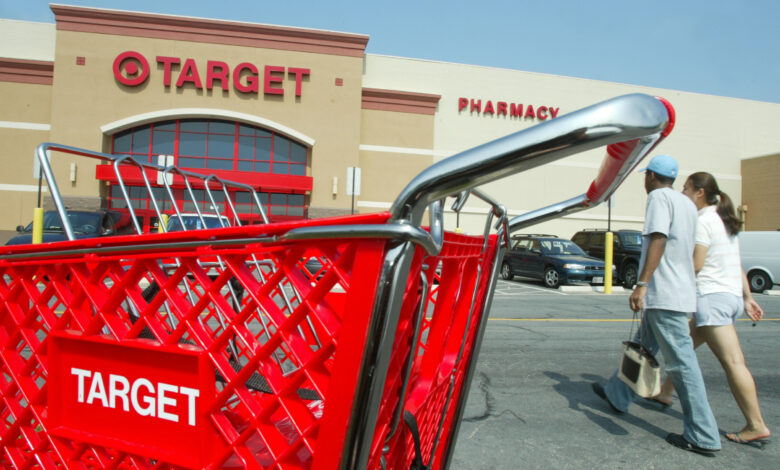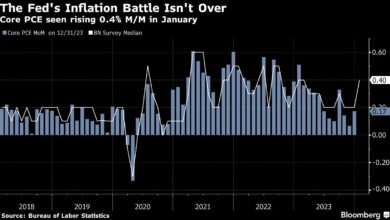The ‘Everyone Wins’ Stock Market Is Dead — Ask Target

(Bloomberg Opinion) — Target Corp.’s sales slump last quarter marked the latest example of supposed softening in US consumption, making some stock-market investors jittery that recession could still be in the cards. But the slight moderation in demand — together with increased competition among firms — may be just what policymakers need to vanquish inflation and set the stage for more sustainable growth.
With about 97.1% of companies by market cap reporting, S&P 500 earnings per share are up about 5.9% in the first quarter from a year earlier on revenue growth of about 4.3% — a plainly positive result overall. Yet companies seem to be competing more for the same pool of top-line growth, a development that ultimately benefits consumers and demands that investors get more discerning.
Just 296 of the S&P 500 companies grew sales from a year earlier, which marks some of the weakest sales breadth since 2020, according to Bloomberg Intelligence data. But those numbers aren’t terrible or recessionary from a historic standpoint; they’re just not consistent with the “everyone wins” stock market we’d gotten used to. Even within the same industries and product categories, some firms are doing much better than others at catering to shifting tastes, marketing and selectively discounting to capture market share.
For example, consumers seem to be tiring of Starbucks Corp. coffee, but they’re as hungry as ever for Chipotle Mexican Grill Inc.’s chicken al pastor. Target is struggling with declining same-store sales, yet Walmart Inc. is using its “everyday values” reputation to lure more higher-income customers. And in travel, Booking Holdings Inc. had an excellent quarter; Airbnb Inc. did so-so (and offered a tepid outlook); and Expedia Group Inc. was downright disappointing.
This is how it’s supposed to work. From 2021-2023, companies took advantage of relatively flush consumers to push through price increases, many justified by higher input costs — and some not. But as savings accounts have returned to normal, companies are thinking long and hard about market share, not just price. Many economic Cassandras highlighted the recent decline in Starbucks sales as proof that the consumer is cracking. Actually, I suspect customers are just tired of its 1990s vision of the coffeehouse experience.
Anecdotes always have the potential to mislead us, but that’s particularly true in the pandemic and post-pandemic eras. The composition of spending has been constantly in flux, with demand for goods exploding in 2020-2021 before handing the baton to discretionary services such as concerts and sporting events. Both of those categories have benefited from the fact that many homeowners locked in ultra-low mortgage payments pre-2022, capping their housing expenditures as a percentage of disposable income. But the spending mix may yet shift again if the housing market thaws and homebuyers decide to reallocate concert-ticket budgets to help them buy a new McMansion.
No, the economy isn’t perfect, and, yes, some households are suffering, including many young adults.
The Federal Reserve Bank of New York’s Quarterly Report on Household Debt and Credit showed that 9.9% of 18- to-29-year-olds’ credit card debt transitioned into serious delinquency in the first quarter, the highest since 2010. Likewise, 4.9% of their auto loans did the same, the highest since 2009. Then again, total transitions into serious delinquency stood at just 2.4% for the 18-29 cohort, thanks to low levels of distress in housing and, to an extent, student loan forgiveness. Across age groups and product categories, transitions into serious delinquency stood at just 1.5% — still well below pre-pandemic norms. In a world experiencing tectonic shifts in consumer spending habits, it’s important to focus on the big picture and take hyper-specific “cracks” with a grain of salt.
In that sense, current developments in the retail and consumer services landscape are mostly in line with what you would hope and expect. Consumption isn’t seizing up, and most consumers aren’t teetering on the brink of financial catastrophe; they’re just getting choosier and forcing companies to fight for their business. One example: Target says it is lowering prices on 5,000 popular items. That indicates that price pressures may continue to abate, hopefully in time for surgical policy rate cuts later in the year. As long as that happens, easier borrowing conditions will arrive with ample time to keep consumption buoyant and the American economy humming along.
More From Bloomberg Opinion:
Want more Bloomberg Opinion? OPIN <GO>. Or you can subscribe to our daily newsletter.
To contact the author of this story:
Jonathan Levin at [email protected]





